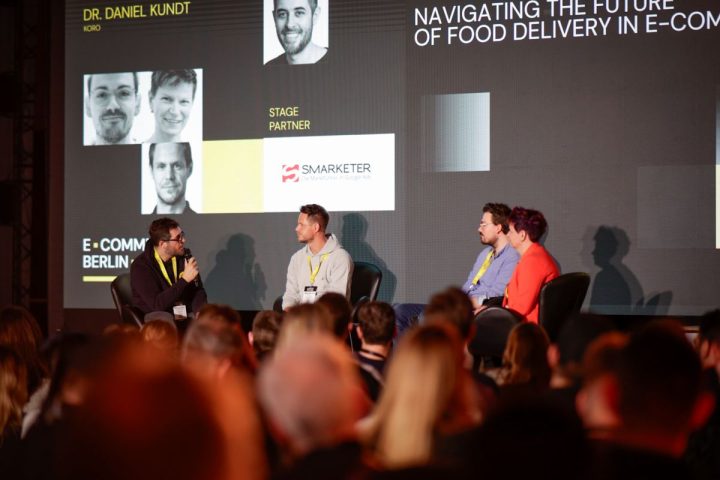DATA, AI, MOBILE: DIGITAL COMMERCE & MARKETING TRENDS 2018 – what’s hot, and what’s not
Written by
Editorial TeamPublished on

The value of the German e-commerce increased by 10% in 2017. The year 2018 brought another 10% rise. This business is now worth about 63 Mill. Euro (85 Mill. according to another source). Digital has revolutionized trade in a way, that it’s no longer a question of will, but a question of survival. Not only is it necessary in the retail industry, but other businesses also have to communicate with their client – wherever they may be.
People are using so many devices and numerous platforms and because of this, and because of this marketing activities have to take place through various channels, often differing from each other vastly. What results from that is an enormous amount of data about customer behavior.
Artificial Intelligence AI – THE Buzzword 2018
In the e-tailment 2018 Trends summary, most experts mentioned Artificial Intelligence as the biggest hype for the upcoming year, and indeed it was. Maybe, because this term recalls science-fiction movies and gives us a feeling of entering a whole new era. But AI has nothing to do with real human intelligence. What actually stands behind AI are numerous, various algorithms, which contribute to already existing, or even well-established developments in online-marketing. Just to name a few: personalization, dynamic pricing, voice assistants and chatbots.
PERSONALIZATION – buzzword became reality and than.. necessity
Personalization is about recognizing the client and based on this, offering services or content which at a given point in time may be relevant to them. In order to do so, data of previous actions, demographics or geolocalization is used.
What is interesting, is that clients were sceptical at first about algorithms processing data about their behaviour. Now they crave personalized content. Not using personalization actually cost businesses money, in the last year, businesses have lost $756bn because of poor personalization.
A study has found two reasons why we prefer a tailored online experience. First of all, we feel overloaded with the omnipresent information and appreciate receiving data that is relevant to us. Secondly, seeing “our own personal” version of an e-store gives us an illusion of having control over the world around us.
Facebook wall, pinterest’s suggestions, spotifiy’s curated playlists, are all experiences based solely on personalization. But, as this trend turns out to be so vital, there is constant room for improvement. 64% of people surveyed were willing to share personal data in return for relevant content, but only 31 % are happy with digital advertisements, another 35% are tired of seeing same adds all over again.
Customization – is the next step after personalization, where the user adjusts the product or service by himself and can have a more tailored experience. With NIKEID one can change the type of material and even add their own logo. Similar service is provided by Ray Ban.

https://store.nike.com/de/de_de/

https://www.ray-ban.com/usa/customize
M-COMMERCE – trade has to be there, where the customer is
“European Mobile Commerce Study“ by Mastercard from November 2018 states, that
80% of Europeans and 84% of Germans buy on their mobile device; 75% use shopping apps for that. Increased simplicity of the mobile shopping experience seems to be the main drive for such purchases (Fig. 1).
 (Fig. 1) „European Mobile Commerce Study“ by Mastercard from November 2018
(Fig. 1) „European Mobile Commerce Study“ by Mastercard from November 2018
There is no doubt about the fact, that e-commerce evolves into m-commerce. The era of websites with merely mobile-optimized RWD is over. Retailers have to redesign their mobile presence with dedicated m-shops. Technologies like Accelerated Mobile Pages (AMPs) and Progressive Web Apps (PWAs) have contributed to this revolution. An example of a british e-shop; Dabenhams shows how after implementing PWA the site almost doubled its speed and mobile conversion increased by 31%.
[su_youtube url=”https://www.youtube.com/embed/Ar0D4LCDcGY”]
According to a study from August 2018, retailers noticed a 50% increase in traffic on their mobile websites vs 2017. This means, that every second online-entry results from a mobile device. What’s even more interesting, is that retailers do not know which part of their sales comes from m-commerce.
One could come to a conclusion, that m-commerce is a reality for shoppers, but still a trend for e-retailers, who should adjust to this advancement really quickly.
Another booming trend is mobile payment. A study from E-Marketer states that about 5,8 milions Germans would rather pay with their smartphone – that is 36% more than in 2017. This adds up to 11% of all mobile phone users – a rather modest number in comparison with Italy (20%) and UK (17%), but things are changing. As of June 2018 one can pay in Germany using Google Pay and Apple Pay is soon to come. It’s introduction has been announced for November, but this service is not yet available (visit apple.com for up-to date status).
BLOCKCHAIN – it’s great but we still don’t know how
The term is well-known because of the cryptocurrency “bitcoin” and other financial systems, but its usage is planned to revolutionize supply chain management, voting and internet – anywhere information is gathered and tracked.
With blockchain data is stored in a distributed ledger – not in a centralized silo, with a single owner. This decentralized, transparent network grants more security to the data and gives a better opportunity to trace it.
Media in 2018 was full of descriptions of possible applications and benefits of blockchain. Starting from systems of certificates of authenticity of Diamonds or other luxury items to the idea of integrated storage of data on all online behaviours of website users. Generally speaking it will bring a new World free from corruption, disrupting monopolists.
After cryptocurrency, supply chain seems to be the next field of application of blockchain. In september, Walmart announced that in a years time their food supply data will be uploaded to the blockchain. The goal is to be able to track the source of food – for example contaminated with bacteria – efficiently and faster than ever. Time of tracking will be reduced from 7 days to 2.2 seconds, which in turn can save lives.
In fact, until now, it is still to be seen how the blockhain applies in practice. A recent survey of 1004 German companies by Bitkom revealed that 60% have never dealt with blockchain. Just 12% are open to the topic, whereas 9% are critical or even negative about it. The reasons for this scepticism: lack of use cases, not enough blockchain experts and legal uncertainties.
CHATBOTS – why AI might be “artificial” but not yet “intelligence”
Messenger marketing is an absolutely logical step for marketers, with many clients using communicators, why not take advantage of it?
Businesses see possibilities for cost savings, a chance to expand support opportunities to 24/7 and in countless languages. Automated solutions can gather data from customer queries and grant deeper understanding of their needs, subsequently letting businesses mold and reach new customers.
In regards to chatbots, clients seem to have different needs. They want to receive instant response that is related to the question, trustworthy and binding. At the same time they don’t want to feel like they are talking to a machine, having to rephrase their questions numerous times, or receiving irrelevant results (see Pic…xxx)
Bots can be integrated with Facebook Messenger, Skype, Slack, Alexa or with a particular website.
In march 2018 Facebook, launched an innovation Lab in order to let more users interact with bots. At https://chatbottle.co one can browse most popular bots to test their functionality. One of the most popular facebook bot is chatShopper, which suggests products from Zalando UK. In my personal experience, the bot could not find products, which are listed on zalando.uk, even after rephrasing it multiple times.

An interesting approach was launched by LEGO, an advice giving search engine for buying christmas presents. The bot does not allow for one to enter text, it asks questions, and using multiple choice it narrows down its criteria.
Oralb.co.uk launched a chatbot on their website this year. Similiar to the LEGO bot, it’s not talkative. It asks questions with a choice of answers to pick from, helping to choose products suiting the clients needs. The bot also helps find a retailer or e-retailer with the chosen product.

SUMMARY
Artificial Intelligence, Chatbots and Blockchain were hot topics in 2018. Their numerous possible applications look very alluring, but in practice, a lot has to be done for us to see measurable results.
On the other hand, this years surprise was an amazing boom of mobile commerce and the discovery, that e-retailers don’t really know which part of their income is generated on mobile devices.
To wrap this up: the year 2018 was focused on two subjects:
- data: algorithms to make the best use of it (AI, chatbots) and its security (blockchain).
- customer experience: increased usability of mobile (m-commerce) and further development of personalization.

Michalina Sowul, PMP is a digital marketing expert and a project manager with over 10 years experience. She led projects for global clients like P&G, Matell and Daimler. Main focus: German e-commerce market, automation, Amazon, data science.


